
EN
FIG. 1
FIG. 2
FIG. 3
FIG. 4
4
2
3
1
RES ET
C/ F
2
1
2
3
4
5
1
Wireless Indoor and Outdoor Thermometer
OVERVIEW
FRONT VIEW – FIG. 1
1. Remote sensor reception indicator
4. Ice alert LED indicator
BACK VIEW – FIG. 2
: Select temperature unit
: Reset unit to default settings
REMOTE SENSOR – FIG. 3
GETTING STARTED
INSERT BATTERIES
1. Remove the battery compartment.
2. Insert the batteries, matching the polarities (see FIG 2).
after each battery change.
REMOTE SENSOR
1. Open the battery compartment (see FIG 3).
2. Select channel 1 then press
3. Close the battery door.
4. Place the sensor within 30 m (98 ft) of the main unit
using the table stand or wall mount.
TIP
Ideal placements for the sensor would be in any
location on the exterior of the home at a height of not more
than 5 ft and which can shield it from direct sunlight or wet
conditions for an accurate reading (see
NOTE
Use alkaline batteries for longer usage and
consumer grade lithium batteries in temperatures below
SENSOR DATA TRANSMISSION
The sensor reception icon in the remote sensor area
TIP
The transmission range may vary depending on
many factors. You may need to experiment with various
locations to get the best results.
ICE WARNING
If the channel 1 sensor falls between 3°C to -2 °C (37°F to
28°F), LED indicator will fl ash, and will stop fl ashing once
the temperature is out of this range.
RESET
to return to the default settings.
PRECAUTIONS
Do not subject the unit to excessive force, shock, dust,
OUT OUT
OUT OUTOUT OUT
OUT
Do not cover the ventilation holes with any items such
as newspapers, curtains etc.
it, dry it immediately with a soft, lint-free cloth.
Do not clean the unit with abrasive or corrosive
This invalidates the warranty.
Only use fresh batteries. Do not mix new and old
Images shown in this manual may dif
Images shown in this manual may differ from the Images shown in this manual may dif
When disposing of this product, ensure it is
separately for special treatment.
Placement of this product on certain types of wood
may result in damage to its fi nish for which Oregon
Scientifi c will not be responsible. Consult the furniture
instructions for information.
The contents of this manual may not be
without the permission of the manufacturer.
Do not dispose old batteries as unsorted
waste. Collection of such waste separately for special
Please note that some units are equipped with a
battery safety strip. Remove the strip from the battery
compartment before fi rst use.
NOTE
The technical specifi cations for this product and
the contents of the user manual are subject to change
SPECIFICATIONS
ABOUT OREGON SCIENTIFIC
about Oregon Scientifi c products. If you’re in the US and
would like to contact our Customer Care department directly,
www2.oregonscientifi c.com/service/support
www2.oregonscientifi c.com/service/support
For international inquiries, please visit:
www2.oregonscientifi c.com/about/international
www2.oregonscientifi c.com/about/international
EU-DECLARATION OF CONFORMITY
Hereby, Oregon Scientifi c, declares that this Wireless
Indoor and Outdoor Thermometer with LED Ice Alert
(Model: EMR201) is in compliance with the essential
requirements and other relevant provisions of Directive
1999/5/EC. A copy of the signed and dated Declaration
of Conformity is available on request via our Oregon
Scientifi c Customer Service.
FCC STATEMENT
This device complies with Part 15 of the FCC Rules.
Operation is subject to the following two conditions: (1) This
device may not cause harmful interference, and (2) This
device must accept any interference received, including
interference that may cause undesired operation.
241 g (8.5 oz) without battery
-5°C to 50°C (23°F to 122°F)
2 x UM-4 (AAA)
1.5 V batteries
30 m (98 ft) unobstructed
-20°C to 60°C (-4°F to 140°F)
1 x UM-3 (AA) 1.5 V batteries
Changes or modifi cations not expressly
approved by the party responsible for compliance could
void the user’s authority to operate the equipment.
This equipment has been tested and found
to comply with the limits for a Class B digital
pursuant to Part 15 of the FCC Rules. These limits are
designed to provide reasonable protection against harmful
interference in a residential installation.
This equipment generates, uses and can radiate radio
frequency energy and, if not installed and used in
accordance with the instructions, may cause harmful
interference to radio communications. However, there
is no guarantee that interference will not occur in a
particular installation. If this equipment does cause harmful
interference to radio or television reception, which can be
determined by turning the equipment off and on, the user
is encouraged to try to correct the interference by one or
more of the following measures:
Reorient or relocate the receiving antenna.
Increase the separation between the equipment and
Connect the equipment into an outlet on a circuit
different from that to which the receiver is
Consult the dealer or an experienced radio / TV
DECLARATION OF CONFORMITY
The following information is not to be used as contact for
support or sales. Please call our customer service number
(listed on our website at www.oregonscientifi c.com, or on
the warranty card for this product) for all inquiries instead.
Name: Oregon Scientifi c, Inc.
Address: 19861 SW 95th Ave.,Tualatin,
Telephone No.: 1-800-853-8883
Product Name: Wireless Indoor and Outdoor
Manufacturer: IDT Technology Limited
Address: Block C, 9/F, Kaiser Estate,
is in conformity with Part 15 of the FCC Rules.Operation is
subject to the following two conditions: 1) This device may
not cause harmful interference.2) This device must accept
any interference received, including interference that may
cause undesired operation.
Termometro Interno-Esterno senza fi li
con allarme rischio gelate
Modello: EMR201
MANUALE PER L’UTENTE
PANORAMICA
VISTA ANTERIORE – FIG. 1
Indicatore della ricezione del sensore remoto
VISTA POSTERIORE – FIG. 2
consente di selezionare l’unit
consente di ripristinare i valori predefi niti
2. Foro per fi ssaggio a parete
OPERAZIONI PRELIMINARI
INSERIMENTO DELLE BATTERIE
1. Togliere il coperchio del vano batterie.
2. Inserire le batterie, rispettando la polarità indicata
dopo ogni sostituzione di batteria.
4. Riposizionare il coperchio
Installazione del sensore:
1. Aprire il vano batterie (FIG. 3).
2. Selezionare un canale, quindi premere
3. Chiudere il vano batterie.
4. Posizionare il sensore entro 30 m dall’unità principale
utilizzando il supporto da tavolo o il foro per il
SUGGERIMENTO La collocazione ideale del sensore
è un luogo all’esterno dell’abitazione ad un’altezza non
superiore a 1 ½ metro, dove possa essere protetto da luce
solare diretta o umidità per garantire la precisione delle
rilevazioni (FIG. 4).
NOTA
Utilizzare batterie alcaline in caso di uso prolungato
e batterie al litio in ambienti con temperature inferiori allo 0.
TRASMISSIONE DEI DATI DEL SENSORE
L’icona di ricezione del sensore nell’area relativa al
sensore remoto ne indica lo stato:
L’unità principale è alla
ricerca del/i sensore/i.
È stato rilevato un canale.
Impossibile trovare il
sensore.
ALLARME GHIACCIO
Se la temperatura rilevata dal sensore posizionato
sul canale 1 scende tra i
3°C e i -2 °C, l’indicatore
LED lampeggia e smetterà di lampeggiare quando la
temperatura sarà uscita da questa fascia.
FUNZIONE RESET
per ripristinare le impostazioni predefi nite
• Non sottoporre il prodotto a forza eccessiva, urti,
polvere, temperatura o a umidità.
• Non otturare i fori di aerazione con oggetti come
• Non immergere l’unità in acqua. Se si versa del liquido
sul prodotto, asciugarlo immediatamente con un
• Non pulire l’unità con materiali abrasivi o corrosivi.
• Non manomettere i componenti interni. In questo
modo si invalida la garanzia.
• Utilizzare solo batterie nuove. Non mescolare batterie
nuove con batterie vecchie.
• Le immagini del manuale possono differire dalla realtà.
• Al momento dello smaltimento del prodotto, utilizzare
la raccolta differenziata.
• Oregon Scientifi c declina ogni responsabilità per
eventuali danni alle fi niture causati dal posizionamento
del prodotto su determinati tipi di legno. Consultare le
istruzioni fornite dal fabbricante del mobile per ulteriori
• Il contenuto di questo manuale non può essere
ristampato senza l’autorizzazione del fabbricante.
• Non smaltire le batterie vecchie come rifi uto non
differenziato. È necessario che questo prodotto venga
smaltito mediante raccolta differenziata per essere
trattato in modo particolare.
• Alcune unità sono dotate di una striscia di sicurezza
per le batterie. Rimuovere la striscia dal vano batterie
prima del primo utilizzo.
Le specifi che tecniche del prodotto e il contenuto
del manuale per l’utente possono essere modifi cati senza
SPECIFICHE TECNICHE
INFORMAZIONI SU OREGON SCIENTIFIC
Per avere maggiori informazioni sui nuovi prodotti Oregon
Scientifi c visita il nostro sito internet
, dove potrai trovare tutte le informazioni di cui hai bisogno.
Per ricerche di tipo internazionale puoi visitare invece il
.com/about/international.asp
.com/about/international.asp
DICHIARAZIONE DI CONFORMITA’ UE
Con la presente Oregon Scientifi c dichiara che questo
prodotto (Modello: EMR201) è conforme ai requisiti
essenziali ed alle altre disposizioni pertinenti stabilite
dalla direttiva 1999/5/CE. Una copia fi rmata e datata della
Dichiarazione di Conformità è disponibile, su richiesta,
tramite il servizio clienti della Oregon Scientifi c.
PAESI CONFORMI ALLA DIRETTIVA R&TTE
Tutti I Paesi Ue, Svizzera CH
TIPO DESCRIZIONE
UNITÀ PRINCIPALE
L x P x H
Peso 241 g (batterie escluse)
Campo di misurazione da -5°C a 50°C
della temperatura
Risoluzione 0.1°C (0.2°F)
Frequenza segnale 433 MHz
Alimentazione 2
UNITÀ REMOTA (THN132N)
L x P x H 96 x 50 x 22 mm
Peso 62 g
Campo di trasmissione 30 m senza ostruzioni
Campo di misurazione della da -20°C a 60°C
temperatura
Alimentazione 1 batteria UM-3 (AA)
da 1,5 V
Tutti I Paesi Ue, Svizzera CH
Thermomètre intérieur et extérieur
sans fi l avec LED d’alerte gel
VUE D’ENSEMBLE
VUE AVANT – FIG. 1
1. Indicateur de réception de la sonde sans fi l
2. Température extérieure
3. Température intérieure
4. Indicateur LED du niveau de gel
Permet de sélectionner l’unité de mesure de la
Réinitialise l’appareil aux réglages par défaut
2. Trou de fi xation murale
3. Compartiment des piles
POUR COMMENCER
INSTALLATION DES PILES
1. Retirez le couvercle du compartiment des piles.
2. Insérez les piles, en respectant les polarités (voir FIG 2).
(REINITIALISER) après chaque
Installation de la sonde :
1. Ouvrez le couvercle pour accéder au compartiment
2. Sélectionnez un canal puis appuyez sur
3. Fermez le couvercle du compartiment des piles.
4. Installez la sonde à 30 m maximum (98 pieds) de
l’appareil principal à l’aide du support de table ou de la
L’extérieur de la maison est le meilleur endroit
pour installer la sonde, à une hauteur de 152.4 centimètres
maximum et non exposée aux rayons directs du soleil ou à
l’humidité pour assurer la précision des données (
Utilisez des piles alcalines pour un usage
prolongé et des piles au lithium pour la consommation lors
de températures inférieures au gel.
TRANSMISSION DES DONNEES DE LA SONDE
Réinitialisez l’appareil.
L’icône de réception de la sonde situé sur la zone de la
sonde sans fi l vous indique le statut de la transmission :
Si la sonde du canal 1 passe entre 3°C et -2 °C (37°F à
28°F), l’indicateur LED clignote et ne s’arrêtera que si la
température sort de cette gamme.
pour que l’appareil revienne aux
EMPLACEMENT SIGNIFICATION
EMPLACEMENT SIGNIFICATION
EMPLACEMENT SIGNIFICATION
Piles faibles (Appareil principal)
Piles faibles (Appareil principal)
Zone de température
Piles faibles (Appareil principal)
Zone de température
Piles de la sonde faibles
L’appareil principal est à la
recherche de la/des sonde(s).
recherche de la/des sonde(s).
recherche de la/des sonde(s).
recherche de la/des sonde(s).
recherche de la/des sonde(s).
recherche de la/des sonde(s).
OU
Un canal a été trouvé.
OU
T
Un canal a été trouvé.
T
OU
Un canal a été trouvé.
OU
TO
Un canal a été trouvé.
TO
T O
Un canal a été trouvé.
TO
UT
Un canal a été trouvé.
UT
OU
Un canal a été trouvé.
OU
T
Un canal a été trouvé.
T
La sonde est introuvable.
• Ne pas soumettre le produit à une force excessive, au
choc, à la poussière, aux changements de température
• Ne pas couvrir les trous de ventilation avec des
• Ne pas immerger le produit dans l’eau. Si vous
renversez du liquide sur l’appareil, séchez-le
immédiatement avec un tissu doux.
• Ne pas nettoyer l’appareil avec des matériaux corrosifs
• Ne pas trafi quer les composants internes. Cela
invalidera votre garantie.
• N’utilisez que des piles neuves. Ne pas mélanger des
• Les images de ce manuel peuvent dif férer de l’aspect
• Lorsque vous désirez vous débarrasser de ce produit,
assurez-vous qu’il soit collecté séparément pour un
• Le poser sur certaines surfaces en bois peut endommager
la fi nition du meuble, et Oregon Scientifi c ne peut en être
tenu responsable. Consultez les mises en garde du
fabricant du meuble pour de plus amples informations.
• Le contenu du présent manuel ne peut être reproduit
sans la permission du fabriquant.
• Ne pas jeter les piles usagées dans les containers
municipaux non adaptés. Veuillez effectuer le tri de
ces ordures pour un traitement adapté si nécessaire.
• Veuillez remarquer que certains appareils sont équipés
d’une bande de sécurité. Retirez la bande bande
ducompartiment des piles avant la première utilisation.
Les caractéristiques techniques de ce
roduit et le contenu de ce manuel peuvent être soumis à
CARACTERISTIQUES
À PROPOS D’OREGON SCIENTIFIC
Pour plus d‘informations sur les produits Oregon
France, rendez-vous sur notre site:
Si vous êtes aux Etats-Unis, vous pouvez contacter notre
support consommateur directement sur le site:
par téléphone au: 1-800-853-8883
Pour des renseignements internationaux, rendez vous sur le
.com/about/international.
EUROPE - DECLARATION DE CONFORMITE
Par la présente Oregon Scientifi c déclare que l’appareil
Thermomètre intérieur et extérieur sans fi l avec LED d’alerte
gel (Modèle: EMR201) est conforme aux exigences essentielles
et aux autres dispositions pertinentes de la directive 1999/5/CE.
Une copie signée et datée de la déclaration de conformité est
disponible sur demande auprès de notre Service Client.
Tous les pays Européens, la Suisse
L x l x H 96 x 50 x 22 mm
(3,78 x 1,97 x 0,87 pouces)
de transmission Distance de transmission Distance
30 m (98 pieds) sans obstruction
Alimentation 1 pile UM 3 (AA) 1,5 V
(2.59 x 1.08 x 3.44 pouces)
241 g (8,5 onces) sans piles
-5°C à 50°C (23°F à 122°F)
-5°C à 50°C (23°F à 122°F)
température
-5°C à 50°C (23°F à 122°F)
Fréquence du signal 433 MHz
(2.59 x 1.08 x 3.44 pouces)
Fréquence du signal 433 MHz
L x l x H 96 x 50 x 22 mm
Alimentation 1 pile UM 3 (AA) 1,5 V
Funkthermometer innen/ außen
ÜBERSICHT
VORDERANSICHT – ABB. 1
1. Empfangsanzeige für Funksendeeinheit
4. LED-Indikator für Frostwarnung
Temperatureinheit auswählen
Gerät auf Standardeinstellungen zurücksetzen
FUNKSENDEEINHEIT – ABB. 3
2. Öffnung für Wandmontage
ERSTE SCHRITTE
BATTERIEN EINLEGEN
1. Öffnen Sie das Batteriefach.
2. Legen Sie die Batterien ein und achten Sie auf die
Übereinstimmung der Polaritäten (siehe ABB. 2).
3. Nach jedem Batteriewechsel auf
So richten Sie die Sendeeinheit ein:
1. Öffnen Sie das Batteriefach (siehe ABB. 3).
2. Wählen Sie einen Kanal aus und drücken Sie auf
3. Schließen Sie die Batterieklappe.
4. Platzieren Sie die Sendeeinheit mit dem Tischaufsteller
oder der Wandaufhängung innerhalb von 30 m von
der Basiseinheit entfernt.
Die ideale Platzierung der Sendeeinheit wäre eine
beliebige Stelle an der Außenseite Ihres Hauses, in einer
Höhe von etwa 150 cm, die vor direkter Sonnenbestrahlung
und Feuchtigkeit geschützt ist, um präzise Messwerte zu
gewährleisten (siehe ABB.4).
Verwenden Sie Alkaline-Batterien für längere
Betriebsdauer sowie Lithium-Batterien für Endverbraucher
bei Temperaturen unter dem Gefrierpunkt.
DATENÜBERTRAGUNG DER SENDEEINHEIT
So suchen Sie nach einer Sendeeinheit:
Setzen Sie das Gerät zurück.
Das Sensor-Empfangssymbol im Bereich der Funksendeeinheit
Wenn die Sendeeinheit des Kanals 1 auf einen Wert zwischen
3 °C und -2 °C (37 °F bis 28 °F) abfällt, blinkt der LED-Indikator;
er hört auf zu blinken, wenn sich die Temperaturwerte wieder
außerhalb dieses Bereichs befi nden.
Standardeinstellungen zurückzusetzen.
EHR GEEHRTE KUNDIN, SEHR GEEHRTER KUNDE
Machen Sie mit und Ieisten Sie Ihren Beitrag zum
• Verbrauchte Batterien gehören nicht In den Hausmüll.
Innentemperatur-Bereich Batterien der Basiseinheit sind
Innentemperatur-Bereich Batterien der Basiseinheit sind
Außentemperatur-Bereich Batterien der Sendeeinheit sind
Außentemperatur-Bereich Batterien der Sendeeinheit sind
Basiseinheit sucht Sendeeinheit(en).
Basiseinheit sucht Sendeeinheit(en).
OU
Basiseinheit sucht Sendeeinheit(en).
OU
T
Basiseinheit sucht Sendeeinheit(en).
T
Basiseinheit sucht Sendeeinheit(en).
Basiseinheit sucht Sendeeinheit(en).
OU
Basiseinheit sucht Sendeeinheit(en).
OU
T
Basiseinheit sucht Sendeeinheit(en).
T
Ein Kanal wurde gefunden.
Ein Kanal wurde gefunden.
OU
Ein Kanal wurde gefunden.
OU
T
Ein Kanal wurde gefunden.
T
Ein Kanal wurde gefunden.
Ein Kanal wurde gefunden.
Ein Kanal wurde gefunden.
Ein Kanal wurde gefunden.
Ein Kanal wurde gefunden.
Ein Kanal wurde gefunden.
Ein Kanal wurde gefunden.
Ein Kanal wurde gefunden.
Ein Kanal wurde gefunden.
OU
Ein Kanal wurde gefunden.
OU
TO
Ein Kanal wurde gefunden.
TO
T O
Ein Kanal wurde gefunden.
TO
UT
Ein Kanal wurde gefunden.
UT
OU
Ein Kanal wurde gefunden.
OU
T
Ein Kanal wurde gefunden.
T
Die Sendeeinheit konnte nicht
Die Sendeeinheit konnte nicht
OU
Die Sendeeinheit konnte nicht
OU
T
Die Sendeeinheit konnte nicht
T
• Sie können verbrauchte Batterien bei einer Sammelstelle für
Altbatterien bzw. Sondermüll abgeben. Bitte informieren Sie
sich bei der zuständigen kommunalen Abteilung.
Bitte beachten Sie, dass manche Ger
einem Batterieunterbrechungsstreifen best
dem ersten Gebrauch, bitte den Batterieunterbrechungsst
reifen aus dem Batteriefach entfernen. Beachten Sie zum
ffnen des Batteriefachs die Bedienungsanleitung.
• Setzen Sie das Gerät keiner extremen Gewalteinwirkung
und keinen Stößen aus, und
halten Sie es von übermäßigem
Staub, Hitze oder Feuchtigkeit fern.
abdecken, wie z.B. Zeitungen, Vorhänge, usw.
• Tauchen Sie das Gerät niemals in Wasser. Falls Sie
eine Flüssigkeit über das Gerät verschütten, trocknen
Sie es sofort mit einem weichen, faserfreien Tuch.
• Reinigen Sie das Gerät keinesfalls mit scheuernden
• Machen Sie sich nicht an den internen Komponenten
des Geräts zu schaffen, da dies zu einem Verlust der
• Verwenden Sie nur neue Batterien. Verwenden Sie
keinesfalls neue und alte Batterien gemeinsam.
• Die in dieser Anleitung dargestellten Abbildungen
können sich vom Original unterscheiden.
• Entsorgen Sie das Gerät ausschließlich in den dafür
vorgesehenen, kommunalen Sammelstellen, die Sie
bei Ihrer Gemeinde erfragen können.
• Wenn dieses Produkt auf bestimmte
für solche haftbar für solche haftbar
Beschädigungen. Entsprechende Hinweise entnehmen
• Der Inhalt dieser Anleitung darf ohne Genehmigung
des Herstellers nicht vervielfältigt werden.
• Verbrauchte Batterien gehören nicht in den Hausmüll.
Bitte geben Sie sie bei einer Sammelstelle für
Altbatterien bzw. Sondermüll ab.
• Bitte beachten Sie, dass manche Geräte mit einem Btterieunt
erbrechungsstreifen bestückt sind. Vor dem ersten Gebrauch
müssen Sie den Streifen aus dem Batteriefach ziehen.
Die technischen Daten für dieses Produkt
und der Inhalt der Bedienungsanleitung können ohne
Benachrichtigung geändert werden.
Besuchen Sie unsere Website
erfahren Sie mehr über unsere Oregon
-Produkte. Auf Scientifi c-Produkte. Auf Scientifi c
der Website fi nden Sie auch Informationen, wie Sie im Bedarfsfall
unseren Kundendienst erreichen und Daten herunterladen
Für internationale Anfragen besuchen Sie bitte
den grundlegenden Anforderungen und anderen relevanten
Vorschriften der Richtlinie 1999/5/ EG übereinstimmt. Eine
Kopie der unterschriebenen und mit Datum versehenen
Konformitätserklärung erhalten Sie auf Anfrage über unseren
Scientifi c Kundendienst.Scientifi c
KONFORM IN FOLGENDEN LÄNDERN
Alle Länder der EU, Schweiz CH
Gewicht 241 g (ohne Batterie)
Gewicht 241 g (ohne Batterie)
-5 °C bis 50 °C (23 °F bis 122 °F)
Aufl ösung 0,1 °C (0,2 °F)
Aufl ösung 0,1 °C (0,2 °F)
FUNKSENDEEINHEIT (THN132N)
L x B x H 96 x 50 x 22 mm
L x B x H 96 x 50 x 22 mm
Übertragungsreichweite 30 m (ohne Hindernisse)
Übertragungsreichweite 30 m (ohne Hindernisse)
-20 °C bis 60 °C (-4 °F bis 140 °F)
Stromversorgung 1 Batterie UM-3 (AA) 1,5 V
Stromversorgung 1 Batterie UM-3 (AA) 1,5 V
Alle Länder der EU, Schweiz CH
COUNTRIES RTTE APPROVED COMPLIED
All EU countries, Switzerland
EMR201_OSI-E_MU_R3.indd 1 7/23/07 10:56:57 AM

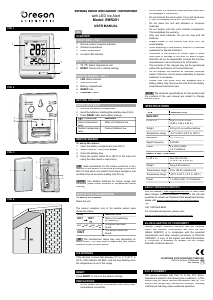



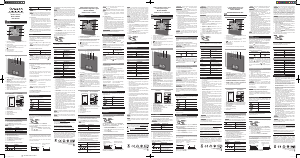
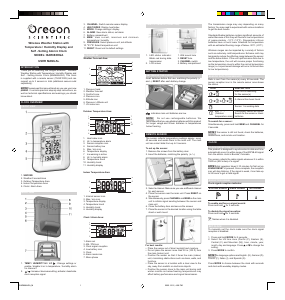
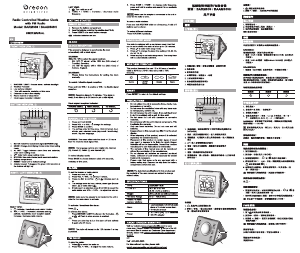

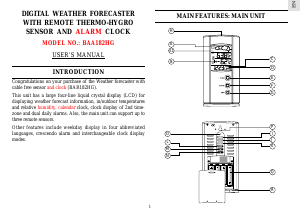
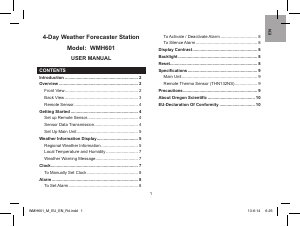
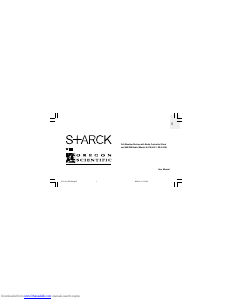
Join the conversation about this product
Here you can share what you think about the Oregon EMR201 Weather Station. If you have a question, first carefully read the manual. Requesting a manual can be done by using our contact form.